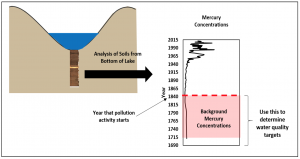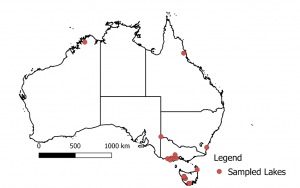As many members of the Mercury Australia team have previously found, many waterways around the world are experiencing increasing levels of mercury. High mercury levels in waterways lead to dire environmental and public health consequences.
The restoration of these waterways suffering from high mercury levels is hindered by the fact that we do not know how much mercury was in these waterways before the mercury pollution occurred. To find out the natural mercury levels, we need mercury concentration data from over 200 years ago (prior to industrialisation, urbanisation and the use of pesticides), which are not available.
Our research, published recently in Elementa: Science of the Anthropocene, uses lake sediments (soils from the bottom of lakes) to determine the natural mercury levels in waterways prior to industrialisation in Australia. Lake sediments are like time capsules – they record the events that have taken place in the lake over time. So, lake sediment cores can be used reconstruct the history of mercury pollution in these lakes, and identify the mercury levels present in these lakes over 200 years ago (Fig. 1).

We obtained sediments from 21 lakes across Australia and quantified the mercury concentrations in sediments that were deposited prior to industrialisation (Fig. 2). We found that the ‘natural’ or ‘pre- pollution’ mercury concentrations in these lakes vary significantly across Australia. Furthermore, the mercury concentrations in the sediments deposited prior to industrialisation were almost 9 times lower than the current guidelines for mercury concentration in sediments. This suggests that if we want to restore our waterways to the ‘natural condition’, we need to determine site-specific pre- pollution mercury concentrations and use these concentrations as restoration targets. Instead of a ‘cookie cutter’ approach to waterway management, site-specific restoration targets are needed.

In this study, we provide information that can be used by natural resource management agencies to manage mercury contamination. This is important to consider especially now as Australia considers whether to ratify the Minamata Convention.
By Dr Anna Lintern (Monash University)
Co-authors of study: Dr Larissa Schneider (ANU), Dr Kirsten Beck (University of Lincoln), Dr Michaela Mariani (University of Nottingham), A/Prof Michael-Shawn Fletcher (University of Melbourne), Prof Peter Gell (Federation University), Prof Simon Haberle (ANU)


Twitter